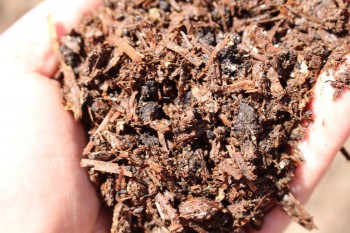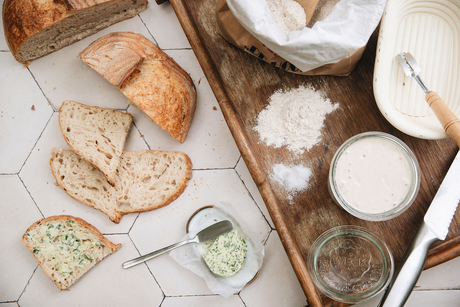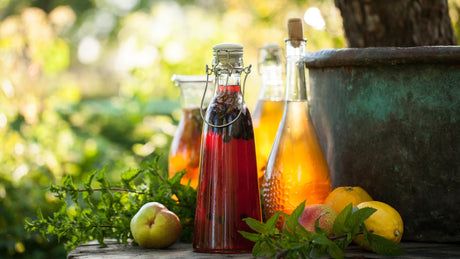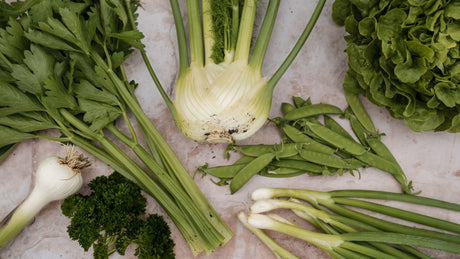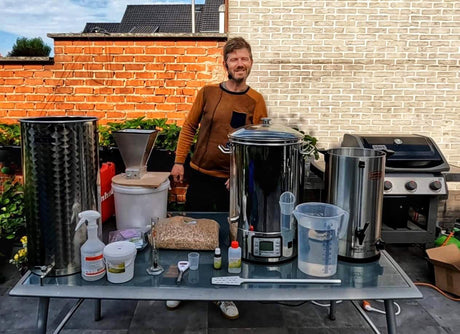Champost or mushroom manure - a powerful soil improver in the vegetable garden
Champost, better known as mushroom manure, is the soil on which mushrooms are grown. Champost is often confused with compost . However, there are major differences between the two brown crumbly masses. To be clear, champost is a soil improver, not potting soil or sowing and cutting soil. It improves the structure of your vegetable garden soil, feeds your soil life and also contains many directly absorbable nutrients. More about this later.
 Cross section of mushroom compost + cover layer in the nursery
Cross section of mushroom compost + cover layer in the nurseryChampost contains horse manure, chicken manure, composted straw and lime
In contrast to “real compost ”, mushroom manure is not made from exclusively vegetable materials. Mushrooms are grown on horse manure that is composted together with straw, lime and chicken manure. Mushrooms are grown on two layers of soil, mushroom compost and cover soil. The mushroom compost is completely hygienised (steamed) outside the mushroom farm and then rests for 14 days in a tunnel before it goes to the mushroom grower. When delivered to a mushroom grower, the mushroom compost is laid down +/- 18 cm thick and provided with a layer of cover soil of 6 to 7 cm. This cover soil consists of approximately 80% peat, mainly black peat in combination with husk peat and, to bring the acidity level up to the right level, foam soil or marl. This cover soil contains all the nutrients for the mushrooms and also the culture or the spores of the mushrooms. The top layer and the bottom layer are then sold again after the harvest as champost or mushroom manure. You can read later about the nutrients champost contains.
Champost is free of weed seeds, your back will be happy too
Mushroom manure is then free of weed seeds and other pests or diseases. Champost is also the cheapest product that contains so much organic material. It is also a product that completes the circle of recycling if you can reuse this champost as a soil improver in the vegetable garden.
Mushroom compost adapts to your soil and makes it better
A big advantage of champost is that it adapts quickly to any type of soil. Heavy clay or loam soils become lighter and airier. Light sandy soils retain moisture better and longer because of the champost because it contains 5 to 10% peat. Champost also has a positive effect on acidic soils because of its dose of lime . The lime also helps your cabbage crops against clubroot and your tomatoes will certainly not show blossom end rot due to a lack of calcium if you use champost in your tomato bed. The average pH of champost is 6.6, an ideal average for the vegetable garden.
How does champost differ from regular compost or manure?
Green compost or organic compost can make your soil more acidic, champost gives your soil a very good pH (acidity) balance. The champost is also steamed for use in mushroom cultivation. During this process, all weed seeds are also eliminated. It would be very annoying if weed seeds germinated between the mushrooms. But the fact that there are no weed seeds in this vegetable garden substrate also means very good news for our vegetable garden. Champost has a short structure in contrast to stable manure. You can therefore process it well in your vegetable garden. I remember that I often found horse manure in its 'original form' in my garden soil after I had worked it in the winter before. This does not happen with champost. 
Champost is also a form of recycling
Champost or 'finished mushroom compost ' is a residual product of mushroom farms. After cultivation, the mushroom manure is treated at high temperatures and removed. From then on we speak of 'champost'. Champost does not contain any form of germs, nematodes or weed seeds. Champost is virtually free of heavy metals (chemicals). GFT compost often contains a lot of weed seeds and more heavy metals and other contamination such as glass, metal particles and plastic.
What does champost contain that makes it so interesting for the vegetable garden?
At the end of the cultivation process, which takes about 6 months, the space in which the mushrooms are grown is steamed with its entire contents. The substrate champost undergoes a heat treatment in which it is kept at 65°C for 8 hours. This treatment involves a lot of costs. But it is necessary to guarantee the grower that he can work cleanly and disease-free the next time. This product is perfectly usable in the vegetable garden. The amount that must be used depends on the soil type, the fertilization status and the cultivation or planting. We recommend: 1 m³ champost for 10 to 15 m² vegetable garden soil. Always work it in well with a digging fork , spade or garden tiller in the top 25 cm of your vegetable garden soil.
 Champost full of organic material and nutrients
Champost full of organic material and nutrientsOrganic matter that is converted into humus by soil life
Champost brings 107 kilos of organic material per m³ to your vegetable garden soil. That is good news for the structure of your soil because extra organic material means that your vegetable garden soil can retain much more moisture. And not only retain moisture, minerals such as potassium, calcium, magnesium and ammonium also attach themselves to that organic matter. Without organic material, everything washes away. Your soil life, the staff from your vegetable garden, also continues to diligently produce humus if you treat them to a good dose of organic matter. Humus is ready-made food for your vegetable garden plants. Organic matter is a very important indicator of a good soil improver. The organic matter that is brought into your vegetable garden soil via champost is of high quality and remains in the soil for a long time. After a year, 60% of the organic matter of the champost remains for the following years. Every year, 2% of the stable humus in the soil is broken down. However, this humus is important for the yield of your crops! The decomposition of humus must therefore be compensated by the supply of organic matter. Sufficient organic matter in your soil has a positive effect on:
- The soil structure
- The moisture retention capacity of your soil
- Resistance to sludge (Sludge is the clumping of the soil during heavy rainfall)
- The soil workability
- The absorbability of nutrients
Champost contains a good dose of nitrogen
Nitrogen is gradually released from organic material. Only a quarter of all available nitrogen from champost is released in the first year. This means that your champost releases nitrogen to your vegetable garden plants for several years. Nitrogen is very useful for the production of leaves in your vegetable garden plants.
Calcium or lime in mushroom compost
A cubic meter of mushroom compost contains 23 kilos of calcium. As mentioned before, calcium has a beneficial effect on the acidity of your vegetable garden soil. With green compost or organic waste compost, your soil becomes more acidic. Plants need calcium to create their cell walls. The root tips are also better formed with a healthy dose of calcium. Without sufficient calcium, you often get undergrown and rotting vegetables.
Salt content in champost
It is important to know that champost contains relatively much salt. This means that you have to work the soil improver into your vegetable garden soil in time. 6 to 8 weeks before planting or sowing is recommended. If you use champost in the greenhouse , and I would certainly recommend that, then rinse your soil thoroughly afterwards so that most of the salts are washed away from your garden greenhouse. Since the rain cannot do it for you, it is best to rinse your greenhouse with 30 litres per square metre. Important to know, the nutrients do not wash away.
Champost is 100% organic
The composition of champost consists entirely of natural products. There are no strange things in it such as stones, plastic or glass. It would also not be safe to grow mushrooms in such soil. So no rubbish comes with this soil improver in the vegetable garden either.
The Vegetable Garden Facts order mushroom compost
Moestuinweetjes also offers champost in Flanders. In a pure version but also in a composted version. The composted version has a finer structure as it has tarred for 8 weeks. This is the stuff you need. It contains all the ingredients to get started right away. 1 cubic meter of fresh champost contains on average: 170 kg dry matter 107 kg organic matter 3.2 kg nitrogen (N) 2.0 kg phosphate (P2O5) 4.4 kg potassium (K2O) 1.2 kg magnesium (MgO) 0.5 kg sodium (Na2O) 23 kg lime (CaO) Due to the transport costs, it is interesting to buy large quantities. It can be useful to buy the compost together or you can also store the compost under a tarpaulin for a while so that you can process a part in the garden every year. You can simply store the Moestuinweetjes champost in the open air in a pile. The pile will decrease slightly in volume but the nutritional value and structure will remain. Champost should always be worked into the vegetable garden soil before you plant or sow. You can use champost as a weed-free mulch 6 to 8 weeks before planting, but ultimately it is best to work it into your vegetable garden with a spade or fork before you plant or sow. You can order champost in the webshop via this link: compost . Greetings Tom

